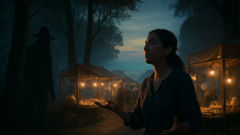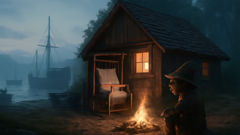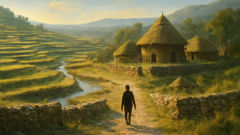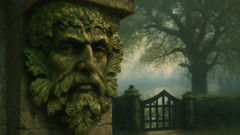Introduction
The island woke with a hush that wasn’t quiet so much as reserved. Chiloe’s mornings arrive not with a shout but with a careful, damp tenderness—the kind of light that slides over wooden planks and treetops like a patient hand. In this land of palafitos, of boats that rock like sleeping gulls and of wind that carries the memory of old songs, people learned to live with legends that pressed close enough to touch. The Trauco is not a creature one nails to a door as a souvenir, nor a monster to fear without dignity. He is a diminutive man of crooked limbs and a face that has forgotten the light of common day. The stories say his ugliness is not merely physical; it is a pattern of the world turned inside out, a jumble of misfit promises that invites the beholder to look away yet cannot. The Trauco’s power does not arise from brute force or loud threats. It emerges from a gaze that seems to know your hidden reveries and then wields them like a craftsman wields a chisel. He teaches, by paradox, that desire is a wind capable of lifting a ship or breaking a harbor’s trust. The island people speak of him with a wary tenderness, as if a dangerous child stood at the edge of the forest, both needing and being feared, capable of kindness one can scarcely imagine and harm one cannot unlearn. This is a story not about a monster who hunts, but about a force that inspects the motives of the heart and asks, with a patient, crystalline voice, what is it you really want, and what do you owe to the wanting itself?
Section I — The Gaze, the Grief, and the Gift
The Trauco appears not as a terror but as a rumor that grows teeth when spoken aloud. He is said to be a dwarf, no taller than a harvest bench, with skin the color of fallen bark and eyes that burn with the stubborn green of sea glass found after a storm. His ugliness wears like a cloak, not to announce deficiency but to signal a kind of truth: beauty is a currency that often prices the vulnerable. In Chiloe, where the nights close like a shawl and the market stalls glow with lanterns, the old women tell stories to keep the children from wandering into the dark too far beyond the harbor lights. They tell of the Trauco’s gaze—how it travels through fabrics, through excuses, through the iron of a man’s complaint, and lands upon a woman’s heart with the precision of a fisherman’s line. The legend has a rhythm, a pulse, a careful meter that sounds like a lullaby and ends like a warning knot tied in a hurry. Yet in these tales there is a different hunger too—a hunger for understanding rather than conquest, for restraint instead of surrender, for a man who can be so dangerous that a life must be rearranged to keep it from causing harm.

I has asked my grandmother why the Trauco cannot Be banished with a word or a hammer. She has fed me with bread and told me to listen to the soft sounds of the wood—how knots in the timber sigh when a storm draws near. She says the Trauco’s power is a mirror held too close to your own desire. If you do not look away, the mirror will reflect your longing back at you and twist it into something you must bear. The Trauco, she says, does not seduce to own a woman, but to awaken in her a memory of longing she hadn’t named and perhaps had forgotten. A young fishing apprentice may feel the tug of a certain ache after a long season of loneliness, and in that ache there lies a question: what would you do if you could turn the ache into a door? The Trauco offers a doorway, but the keys lie in the heart of the seeker. The old women know this, for they have learned that desire is not merely appetite but a weather pattern—sometimes a gentle rain that heals the soil, sometimes a storm that floods the harbor. The Trauco’s gift, if you can call it that, is a dangerous clarity. It makes you see yourself as you are when you are most vulnerable, without the armor of pride or the shield of shame. It is a terrible thing to possess, and a terrible thing to refuse, because refusing asks you to admit that you wanted something you cannot have without consequences.
In the first whisper of the story, a girl named Lucia, daughter of a fisherman, hears the rumor and does not scream. She is not blind to the Trauco’s power, but she has learned to recognize the patterns of power in every corner of her world. Her mother, a seamstress who mends nets and stories alike, tells Lucia to braid her hair with patience and to keep the windows barred more by culture than by fear. Lucia does not seek the Trauco’s gaze; she seeks to understand why eyes can travel so quickly from curiosity to cruelty and back again. The Trauco does not visit Lucia in daylight. He moves in the margins of dusk, when the market stalls close and the sea breathes out a sigh that tastes of salt and old prayers. He appears as a small silhouette among the alder trunks, a creature carved by the island’s patience, with a mouth that seems to smile at mischief and a stare that would rather dissect a secret than reveal a truth.
The turning of this section comes not with a grand confrontation but with a choice. Lucia is offered a power she never sought—the ability to see into the heart of a gaze. Not through cynicism or fear, but through something like mercy that asks for restraint. In the market, a man who has traded his own name for a moment of sweetness finds his life unthreaded by a single look. The Trauco watches, and Lucia learns that the line between desire and harm is not a fixed boundary but a shifting tide that needs careful handling. The sea, which has taught the island how to fish and how to listen, teaches Lucia that to hold a dangerous thing is not to own it but to guide it toward safety. The Trauco’s effect is not the same for every observer: some are drawn into a reverie that dissolves into laughter; others are pulled into a memory of a memory they cannot quite place, and in that memory they recover a part of themselves they thought they'd lost to time. The lesson, if such a thing can be pulled from the net of legends, is that power is a conversation between two aware beings: the one who wields it and the one who receives it. The Trauco’s gaze asks, Are you ready to answer for what you crave? Lucia’s answer is a boundary drawn not with anger but with clarity. She speaks aloud to the rumor, naming it what it is: a test, not a trap. And in naming it, she changes the terms of the encounter, making room for choice rather than surrender, for responsibility rather than desire alone. This is the beginning of a longer memory, a memory that will ripple outward from Lucia to the village, and then beyond, like a stone dropped into still water leaving concentric rings that touch the far shore.
Section II — The Pact of Respect: Wisdom Over Witchcraft
The air of Chiloe wears many hats: it can be a stormcloak or a veil, it can be a song that makes the nets hum or a silence that makes the creak of the palafito boards feel like a confession. In the wake of Lucia’s courage, the island’s older voices grow patient again. They tell a second truth about the Trauco, which is not that he is merely a danger to be restrained, but that he is a mirror of the world’s oldest ache—the ache of unspoken boundaries. It is said that in the deepest forest winter, when the wind is a thread pulling the pines together and the rain has a way of remembering every name, the Trauco travels not to claim but to remind. He reminds that power without consent is a blade worn at the neck of another’s heart, and that desire without duty is a ship without a harbor. The villagers begin to learn a ritual, a kind of negotiating dance: those who feel the pull of the Trauco do not flee in panic, but invite the elders to sit with them by the fire, to speak the truth of what they want, to name the fear that accompanies that want, and to listen to the stories of those who have learned how to close the door without slamming it. In this ritual, the Trauco’s power is not conquered, but redirected. His gaze becomes a signal that a boundary exists, that a person’s body is not a curiosity to be evaluated by a stranger’s eyes but a living door that opens only with consent, care, and mutual respect.

The second turning comes with a girl named Mariela, who runs a small loom shop near the harbor. She has a stubborn mind and a patient heart. She has learned to weave not only threads but also agreements, to strengthen the net of community so that the island can hold the weight of stories that do not always end with triumph but always end with something like truth. When the Trauco appears to her, his presence is not a spell cast to bend her will but a challenge to reframe desire as something that can accompany growth rather than devour it. Mariela does not dismiss his danger. Instead, she invites him to sit with her in the smell of wool and resin, to listen to the sound of the loom as it moves, rhythm by rhythm, toward a future where every person can claim the right to their own heart while also honoring another’s. The Trauco, who has never learned to speak in anything but the old language of force, begins to understand a new dialect—one built from listening, apology, and the slow, almost ceremonial power of kindness.
In the weeks that follow, Mariela and Lucia become the custodians of a shared vow: the island will keep its legends, but they will be tempered with care. Families come to the loom-house with questions not about how to banish the Trauco but about how to speak to fear so that fear does not speak back with violence. The elders teach that every gaze carries a possibility—either it can wound or it can awaken a conscience. The Trauco, for his part, accepts a new role: he becomes the guardian of boundaries who must earn the right to approach, who must be allowed entry only through consent and a clear understanding of consequence. This transformation is not a victory parade but a quiet, stubborn hope—a hope that power, when guided by wisdom, becomes a partner rather than an aggressor. The island’s forests hear a new sound in the wind—the sound of a community learning to balance longing with care, the sound of a creature who has learned that ugliness can be a vehicle for humility, not domination. The Trauco’s gaze loses its old magic and gains a tempered glow, a light that does not mesmerize but clarifies: desire is not something to own but a relationship to be navigated with consent, memory, and accountability.
The tale closes not with the Trauco receding into myth's mist, but with a sentient, enduring exchange. Lucia and Mariela become stewards of a banner that the younger generations will carry—a banner stitched from patience, from a grandmother’s regained trust in the world’s complicated tenderness, and from a transformed creature who finally learns to value a boundary as a bridge rather than a barrier. The island remains, as it always has, a place where legends walk at human pace, where the story of ugliness and power isn’t simply a cautionary tale but a guide to a more conscientious future. If you listen closely on a windless night, you can hear the sea whisper a new version of the old refrain: that power is a trust, that desire is a negotiation, and that wisdom often arrives wearing the face you least expect—and asking you to decide what kind of gaze you will offer in return.
Conclusion
The Trauco’s legend remains alive because it was never only about him. It is a perpetual reminder that gaze is a form of agency, and agency demands responsibility. The island of Chiloe, with its palafitos and its salt-stung winds, has learned a harder, wiser memory: power can sharpen your sight and, if you are careful, can expand your heart rather than narrow it. Lucia’s courage and Mariela’s craft prove that culture is not a static relic but a living conversation—between elders and children, between myth and memory, between the ugliness that frightens and the wisdom that heals. When myth travels into the present, it does not disappear; it changes shape, inviting future generations to decide what kind of legends they want to live with. The Trauco remains nearby, not as a warning to be feared but as a partner in a slower, kinder negotiation with desire, power, and consent. In Chile’s fog-washed mornings and in its moonlit nights, people still tell the tale, and in telling, they choose again to be worthy of the gifts their legends promise: a community that remembers to listen, to respect, and to grow together.

















